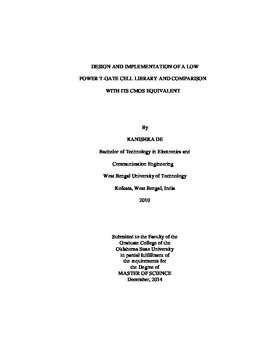| dc.contributor.advisor | Hutchens, Chris | |
| dc.contributor.author | De, Kanishka | |
| dc.date.accessioned | 2015-06-17T20:05:30Z | |
| dc.date.available | 2015-06-17T20:05:30Z | |
| dc.date.issued | 2014-12-01 | |
| dc.identifier.uri | https://hdl.handle.net/11244/14796 | |
| dc.description.abstract | This work presents the design methodologies, considerations and practical implementation techniques of a sub-threshold/ moderate inversion variability aware Transmission Gate based digital cell library. The implementation method of a reduced ASIC cell library containing minimum number of logic gates sufficient for further front end and back end processing is described. The proposed library targets a reduced implementation time and effort suitable for academic and industrial environment aiming minimum power consumption in battery less devices, portable electronic gadgets or wireless micro sensor networks where computation speed is not of prime concern. To the authors best knowledge, none of the literature till date demonstrates clearly and in a consolidated manner the applicability of T-Gate logic topology as a candidate for ultra-low power applications. Hence, a comparison is presented with equivalent low power CMOS logic gates. Circuit behavior can be significantly impacted due to MOSFET parameter variation. Clear simulation based measurement techniques are presented for measuring concerned parameters like input capacitance, Static Noise Margin(SNM) and IOFF of the T-Gate logic cells and compared with its CMOS equivalent at the same PVT corners. It is observed that the T-Gate shows lower normalized input capacitance than CMOS logic gates. A statistical analysis of logic failure is also presented along with its potential solutions for improvement. As compared to the CMOS gates, the T-Gate logic gates are found to demonstrate slightly narrower distribution of the switching threshold point(VTrip) when performed 200 point Monte Carlo simulation taking process variation and mismatch into account. The CMOS gates demonstrate better static noise margin and hence more robust than T-Gate logic cell and suitable for lower supply voltage operation. A comparison of IOFF is presented to compare the static behavior of the two topologies. The details of device and gate sizing methodology are described along with necessary references. The library is characterized and abstracted to generate necessary files for further processing. A target system is synthesized and a seven stage ring oscillator is simulated in both topologies and is compared to make conclusion based on the observations. T-Gate logic cells demonstrate better static behavior but outperformed by its CMOS logic equivalent in terms of energy consumed per cycle within the range of VDDD from 400mV to 600mV. T-Gate logic gates are slower than its CMOS counterpart at any VDDD of operation and insignificant improvement is achieved with increasing power supply. | |
| dc.format | application/pdf | |
| dc.language | en_US | |
| dc.publisher | Oklahoma State University | |
| dc.rights | Copyright is held by the author who has granted the Oklahoma State University Library the non-exclusive right to share this material in its institutional repository. Contact Digital Library Services at lib-dls@okstate.edu or 405-744-9161 for the permission policy on the use, reproduction or distribution of this material. | |
| dc.title | Design and Implementation of a Low Power T-gate Cell Library and Comparison with Its Cmos Equivalent | |
| dc.type | text | |
| dc.contributor.committeeMember | Johnson, Louis G. | |
| dc.contributor.committeeMember | Latino, Carl D. | |
| osu.filename | De_okstate_0664M_13733.pdf | |
| osu.accesstype | Open Access | |
| dc.description.department | Electrical Engineering | |
| dc.type.genre | Thesis | |
| dc.subject.keywords | robust cell library | |
| dc.subject.keywords | sub-threshold/ moderate inversion | |
| dc.subject.keywords | t-gate and cmos topology | |
| dc.subject.keywords | ultra low power | |
| dc.subject.keywords | variability aware design | |
| dc.subject.keywords | vlsi/ circuit design | |
